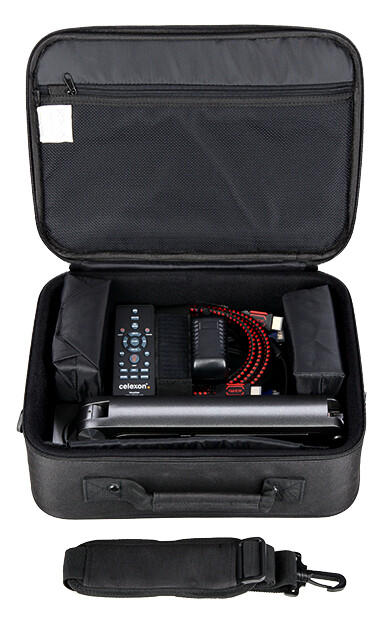















































£244.99*
- Resolution 1920 x 1080 Full HD
- Camera resolution 5 MP
- Focus type Manual & automatic focus


Product information
A strong combination: The set contains our popular celexondocument camera DK500 and the matching celexon projector bag Medium. A matchmade in heaven and perfect for safe long term use.
celexon Document camera DK500
Replace your overhead projector and present documentsinteractively in real time with the celexon document camera DK500. Thanks toits compact housing, low weight and retractable camera arm, the DK500 is idealfor mobile use.
The CMOS sensor with its 5 megapixel resolution provides aclear and detailed image of your documents. In low light conditions, the twoseparately controllable LED lamps can provide light giving you optimalpresentation conditions. With the help of the VGA, USB or HDMI interface, theimage is displayed in up to Full HD resolution (1920x1080 pixels) and at up to60 frames per second on connected devices. Thus, the DK500 can be connected toany standard projector, LCD, TFT, LED, plasma display or interactivewhiteboards. The VGA input allows you to also connect a computer or laptop andto choose whether to display either the feed from the camera or the computers imageryon screen.
The camera arm is tiltable and rotatable and can thus beperfectly aligned to the document or a 3D object. Due to the low minimumfocusing distance (macro function) of about 5cm, individual details can behighlighted. A digital zoom also allows up to 10x magnification.
Thanks to simple and intuitive menu navigation and minimalinstallation requirements, the celexon document camera DK500 is immediatelyready for use (Plug & Play).
Key information:
Resolution up to Full HD 1920 x 1080 at up to 60Hz
High resolution CMOS sensor with 5MP, automaticallyregulates the image brightness
10X magnification
Flexible articulated arm for space-saving transportation
Fully automatic focusing and optional manual one-touchfocusing
Macro function up to 5cm object distance to the lens
Large recording area up to A3 format
Save pictures and videos on SD card™, including yourprepared comments or drawings/markings
2 LED lamps (separately controllable)
Incl. IR remote control
Connectors: SD Card™ slot, HDMI out, VGA in and out, USB
Live comment function (drawing lines and graphics)
Integrated microphone for webcam video teleconferencing
Dimensions: 31 x 11 x 8.5cm (LxWxH)
The handy comment function allows you to annotate the liveimage with lines and geometric shapes using a connected computer mouse or apresenter with mouse function (celexon)
Laser-Presenter Expert LP250). Also, the use of a graphicstablet is possible to insert handwritten notes.
With the celexon document camera DK500 you work isn’t lost,because images and videos (including comments) can be easily achieved andplayed back on an SD card™.
Thanks to the integrated microphone, the use of the documentcamera is also possible as a webcam or for video conferencing. All functionscan be conveniently controlled with the included infrared remote control.
In the box
- celexon Document camera DK500
- 1 x HDMI cable
- 1 x VGA cable
- 1 x USB-A Cable
- 1 x IR Remote control
- Operation manual
celexon Projector Case - Medium
The celexon Projector Case ‘Medium’ protects your projectorwhilst being transported or stored.
The celexon Projector Case is extremely sturdy thanks to itshard shell frame and will protect the contents from being damaged. The exteriorof the bag is washable and waterproof. The plastic feet on the bottom of thecase will protect it from moisture whilst sat on the ground.
The interior space can be customised to fit the casecontents comfortably using the divider and cushion elements included. Inaddition to the main compartment, there are extra pockets for remote controls,CDs, documents and cables. These pockets are sealed with a zip for addedsecurity.
The back pocket can be unzipped at the bottom to double upas a luggage handle attachment, a very handy application for the travellingbusinessperson.
A padded carrying handle and detachable shoulder strap makethe celexon Projector case very comfortable for carrying over longer distances.
Technical Data:
- Material: 100% Polyester
- Width: 32 cm
- Length: 23 cm
- Internal Height: 10 cm
- Colour: Black
Technical data
| Name | celexon Document Camera DK500 with celexon Carry Case M |
|---|---|
| Article number | 1000010442 |
| GTIN/EAN | 4260094740664 |
| Manufacturer SKU | 1000010442 |
| Model name | DK500 |
| variant | With bag |
| Brand | celexon |
| Product Type | Visualizer |
| Product Series | celexon document camera |
| Resolution | 1920 x 1080 Full HD |
| Frames per Second | 60 fps |
| Focus type | Manual & automatic focus |
| Digital Zoom | 10 |
| Camera resolution | 5 MP |
| Camera sensor | CMOS |
| Inputs | 1x VGA |
| Outputs | 1x VGA |
| Certificates | CE tested , ROHS |
| Product width | 41 cm |
| Product height | 15 cm |
| Product depth | 29 cm |
| Weight | 2.6 kg |
| Colour | Silver |
| Delivery contents | Bag , HDMI Cable , Power cable , Quick user guide , Remote control , USB cable , VGA cable , strap |
| Condition | New |
| Warranty | 24 Month |
| Warranty type | Bringin service Service and support information |
Product safety
| Person responsible for the EU |
|---|
| celexon Europe GmbH |
| Gutenbergstraße 2 |
| 48282 Emsdetten |
| Germany |
| info@celexon.de |



